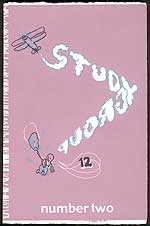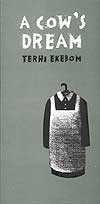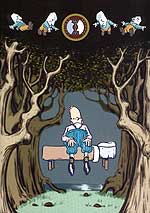 The Anthology "Study Group," from Baton Rouge, Louisiana
The Anthology "Study Group," from Baton Rouge, Louisiana |
MoCCA stands for Museum of Comic and Cartoon Art, a non-profit organization chartered last autumn as the brainchild of attorney and comics fan Lawrence Klein. It intends to "collect, preserve, study, and display the widest possible variety of the world's most popular art form." I wish them well. The last entity to attempt such an endeavor, the Words and Pictures Museum, started out in a building in Northampton, Massachusetts, but eventually gave it up in favor of a "virtual museum" on the web. A bit savvier about location, MoCCA's plan to open a space in Manhattan got put on hold after September 11. But now Klein and co. are talking with the city's downtown redevelopment team. Klein says he hopes to have a place within two years.
 Terhi Ekebom's "A Cow's Dream"
Terhi Ekebom's "A Cow's Dream" |
The MoCCA Art Fest was designed as a small-press-friendly fundraiser for the organization. Spearheaded by Kristen Siebecker, they did everything right, starting with the location: downtown's Puck Building. Originally the headquarters for the humor magazine "Puck," at the turn of the century it was the largest building in world dedicated to lithography. (Non-New Yorkers may recognize it as the location of Grace's office on TV's "Will & Grace.") The elegant decor, with its wood floors and big windows lent a classy air to tables that filled out two big ballrooms. The light and air scared away the one guy dressed as Batman, who must have changed into his Bruce Wayne outfit out of shame. Bike messenger bags, nose-studs and tattoos were the uniform of choice among a refreshingly mixed crowd that put the women to men ratio at an astonishing 1:3. The organizers estimated the total attendance at 2000 people. "It blew away our expectations," Klein said. Siebecker estimated the five-dollar door fee to have brought in around $7000.
It's amazing how much better it gets when the corporate-shill superheroes don't show up. Who needs 'em! This festival kept the focus on creators. Now there was room for one-man or one-woman publishers who offered enticing baked goods and stapled their photocopied books during the down time. Other, more established artists who get marginalized at larger "cons" got the star attention they deserve. Kim Deitch, Phoebe Gloeckner, Paul Pope, Renée French and James Kochalka showed up. Oh yeah, Frank Miller too.
 Paul Hornschemeier's "Forlorn Funnies"
Paul Hornschemeier's "Forlorn Funnies" |
But the best part was discovering new books you wouldn't find anywhere else. "The Cow's Dream," by Terhi Ekebom, a nearly wordless story told with bold graphics in a vertical format came all the way from Finland. Jeffrey Brown's self-published, autobiographical novel, "Clumsy," about a year-long, long-distance love affair has a remarkable vulnerability that gets expressed as much through the scribbly art as the story. Another real find was Paul Hornschemeier's "Forlorn Funnies," a full-color stunner of complex styles that trods ground broken by Chis Ware's "Acme Novelty Library" series. Plenty of smart anthologies could also be had. The beautifully printed "Study Group" has a silk-screened cover and rough-edged paper to match the smart, interesting stories inside.
Let's hope we see the return of such a necessary event. Given the success of the MoCCA Art Festival, both Klein and Siebecker have said they want to do it again. The art form, and New York, needs it.
